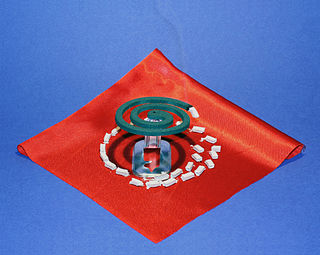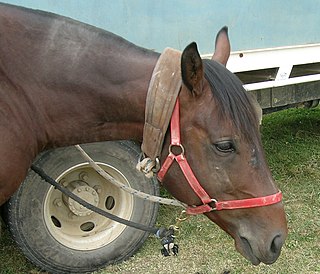
Ultrasound is sound with frequencies greater than 20 kilohertz. This frequency is the approximate upper audible limit of human hearing in healthy young adults. The physical principles of acoustic waves apply to any frequency range, including ultrasound. Ultrasonic devices operate with frequencies from 20 kHz up to several gigahertz.
Diathermy is electrically induced heat or the use of high-frequency electromagnetic currents as a form of physical therapy and in surgical procedures. The earliest observations on the reactions of high-frequency electromagnetic currents upon the human organism were made by Jacques Arsene d'Arsonval. The field was pioneered in 1907 by German physician Karl Franz Nagelschmidt, who coined the term diathermy from the Greek words dia and θέρμη therma, literally meaning "heating through".

Citronella oil is an essential oil obtained from the leaves and stems of different species of Cymbopogon (lemongrass). The oil is used extensively as a source of perfumery chemicals such as citronellal, citronellol, and geraniol. These chemicals find extensive use in soap, candles and incense, perfumery, cosmetic, and flavouring industries throughout the world. Citronella oil is also a plant-based insect repellent and has been registered for this use in the United States since 1948. The United States Environmental Protection Agency considers oil of citronella as a biopesticide with a non-toxic mode of action.

An insect repellent is a substance applied to skin, clothing, or other surfaces to discourage insects from landing or climbing on that surface. Insect repellents help prevent and control the outbreak of insect-borne diseases such as malaria, Lyme disease, dengue fever, bubonic plague, river blindness, and West Nile fever. Pest animals commonly serving as vectors for disease include insects such as flea, fly, and mosquito; and ticks (arachnids).

A bark is a sound most commonly produced from dogs. Other animals that make this noise include, but are not limited to, wolves, coyotes, foxes, seals and barking owls. Woof is the most common onomatopoeia in the English language for this sound. "Bark" is also a verb that describes the sound of many canids.

An electric fence is a barrier that uses electric shocks to deter people and/or other animals from crossing a boundary. The voltage of the shock may have effects ranging from discomfort to death. Most electric fences are used for agricultural fencing and other forms of non-human animal control, although they are also used to protect high-security areas such as military installations or prisons, where potentially-lethal voltages may be used. Virtual electric fences for livestock using GPS technology have also been developed.

An animal collar is a device that attaches to the neck of an animal to allow it to be harnessed or restrained.

Ocean Guardian is the manufacturer of devices that use Shark Shield Technology. The Ocean Guardian electronic devices create an electromagnetic field to deter shark attacks and are used by surfers, scuba divers, snorkelers, spearfishers, ocean kayak fishers, swimming areas off boats and for ocean fishing. It is considered one of the few electrical devices on the market that has performed independent trials to determine the effectiveness at deterring shark attacks, Whilst it is noted the Shark Shield Technology does not work in all situations, new modelling research from Flinders University states that the proper use of personal electronic deterrents is an effective way to prevent future deaths and injuries, it is estimated that these devices can save up to 1063 Australian lives along the coastline over the next 50 years.

An animal repellent consists of any object or method made with the intention of keeping animals away from personal items as well as food, plants or yourself. Plants and other living organisms naturally possess a special ability to emit chemicals known as semiochemicals as a way to defend themselves from predators. Humans purposely make use of some of those and create a way to repel animals through various forms of protection.

Bird scarers is a blanket term used to describe devices designed for deterring birds by startling, confusing or otherwise repeling them, typically employed in commercial settings by farmers to dissuade birds from consuming and defecating on recently planted arable crops. Numerous bird scarers are also readily available to the public direct to consumer, or by means of purchase from independent retailers.

Bird control or bird abatement involves the methods to eliminate or deter pest birds from landing, roosting and nesting.

A bird control spike, also known as an anti-roosting spike, pigeon spike, or roost modification, is a device consisting of long, needle-like rods used for bird control. Bird control spikes can be attached to building ledges, street lighting, and commercial signage to prevent wild or feral birds from perching or roosting. Birds can produce large quantities of unsightly and unhygienic feces, and some birds have very loud calls that can be inconvenient for nearby residents, especially at night. As a result, bird control spikes are used to deter these birds without causing them harm or killing them.

Nuisance wildlife management is the selective removal of problem individuals or populations of specific species of wildlife. Other terms for the field include wildlife damage management, wildlife control, and animal damage control. Some wild animal species may get used to human presence, causing property damage or risking the transfer of diseases (zoonoses) to humans or pets. Many wildlife species coexist with humans very successfully, such as commensal rodents which have become more or less dependent on humans.
Electronic pest control is the name given to any of several types of electrically powered devices designed to repel or eliminate pests, usually rodents or insects. Since these devices are not regulated under the Federal Insecticide, Fungicide, and Rodenticide Act in the United States, the EPA does not require the same kind of efficacy testing that it does for chemical pesticides.

Ultrasonic transducers and ultrasonic sensors are devices that generate or sense ultrasound energy. They can be divided into three broad categories: transmitters, receivers and transceivers. Transmitters convert electrical signals into ultrasound, receivers convert ultrasound into electrical signals, and transceivers can both transmit and receive ultrasound.

Nepeta cataria, commonly known as catnip, catswort, catwort, and catmint, is a species of the genus Nepeta in the family Lamiaceae, native to southern and eastern Europe, the Middle East, Central Asia, and parts of China. It is widely naturalized in northern Europe, New Zealand, and North America. The common name catmint can also refer to the genus as a whole.
Electropositive metals (EPMs) are a new class of shark repellent materials that produce a measurable voltage when immersed in an electrolyte such as seawater. The voltages produced are as high as 1.75 VDC in seawater. It is hypothesized that this voltage overwhelms the ampullary organ in sharks, producing a repellent action. Since bony fish lack the ampullary organ, the repellent is selective to sharks and rays. The process is electrochemical, so no external power input is required. As chemical work is done, the metal is lost in the form of corrosion. Depending on the alloy or metal utilized and its thickness, the electropositive repellent effect lasts up to 48 hours. The reaction of the electropositive metal in seawater produces hydrogen gas bubbles and an insoluble nontoxic hydroxide as a precipitate which settles downward in the water column.
Magnetic shark repellents utilize permanent magnets, which exploit the sensitivity of the Ampullae of Lorenzini in sharks and rays (electrosense). This organ is not found on bony fish (teleosts), therefore, this type of shark repellent is selective to sharks and rays. Permanent magnets do not require power input, making them practical for use in fisheries and as bycatch reduction devices. Sharkbanz, released in 2014, is a wearable commercially available device intended for recreational users. Its manufacturers cite numerous scientific papers which support the effectiveness of permanent magnets in a range of contexts. A field study of a range of shark deterrents in 2018 found that Sharkbanz were ineffective when used in a temperate oceanic setting with berley-attracted Great white sharks.
Acoustic harassment and acoustic deterrents are technologies used to keep animals and in some cases humans away from an area. Applications of the technology are used to keep marine mammals away from aquaculture facilities and to keep birds away from certain areas. The devices have also been employed to keep marine mammals away from fishing nets. The devices are known as acoustic harassment devices (AHDs) and acoustic deterrent devices, which are smaller AHDs or intended as an awareness tool to warn species to the presence of danger rather than as a tool of harassment at a much louder level.

Timothy Grant Leighton is the Professor of Ultrasonics and Underwater Acoustics at the University of Southampton. He is the inventor-in-chief of Sloan Water Technology Ltd., a company founded around his inventions. He is an academician of three national academies. Trained in physics and theoretical physics, he works across physical, medical, biological, social and ocean sciences, fluid dynamics and engineering. He joined the Institute of Sound and Vibration Research (ISVR) at the University of Southampton in 1992 as a lecturer in underwater acoustics, and completed the monograph The Acoustic Bubble in the same year. He was awarded a personal chair at the age of 35 and has authored over 400 publications.















